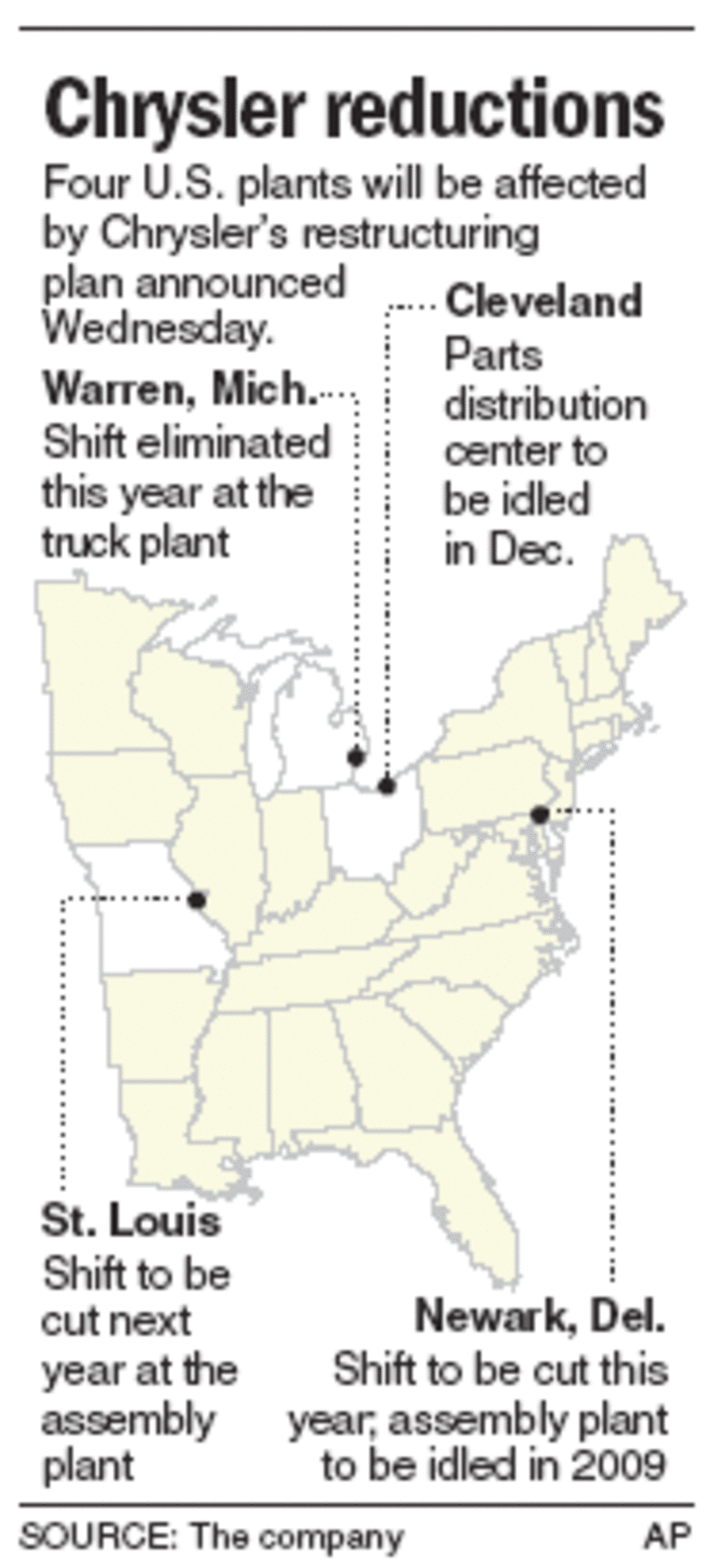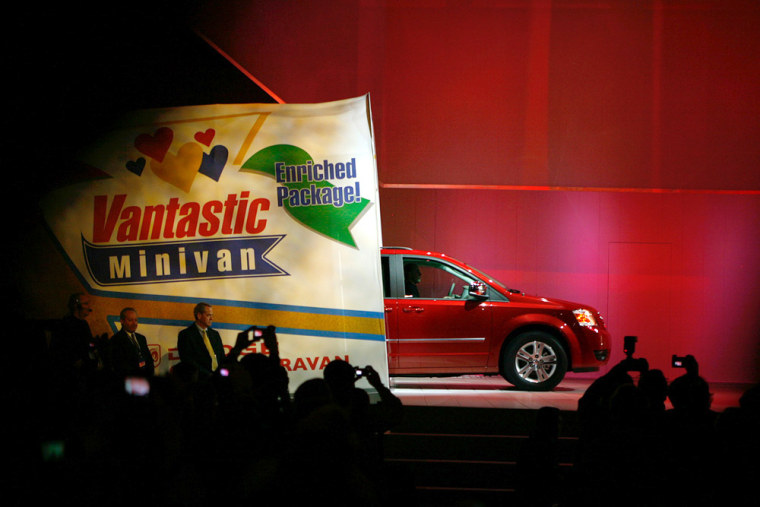It’s becoming an alarmingly familiar event — a large U.S. automaker announces plant closures and thousands of layoffs as it struggles to cut factory capacity to match falling demand for its vehicles.
On Wednesday, it was Chrysler's turn to drop the ax. The U.S. subsidiary of Germany’s DaimlerChrysler said it will cut about 13,000 workers — 16 percent of its North American work force — over the next three years to return its U.S. operations to profitability by 2008.
In unveiling its long-awaited plan, code-named “Project X,” Chrysler follows U.S. rivals General Motors and Ford, which over the past 15 months have announced plans to cut tens of thousands of jobs. All told some 100,000 North American jobs will be eliminated.
Chrysler’s announcement shows the traditional Big Three automakers are suffering from the same disease — a vicious cycle of shrinking market share and tough competition from Asia-based automakers. Like GM and Ford, Chrysler has relied heavily on sales of big pickup trucks and sport utility vehicles that are losing popularity to more fuel-efficient sedans — a market dominated by the Asian brands.
In Chrysler's case, the future is clouded by questions over whether the German parent that acquired it just nine years ago will now consider trying to sell it. DaimlerChrysler Chairman Dieter Zetsche said Wednesday that no option is being excluded from consideration.
Layoffs and plant closures can stanch the flow of red ink at Chrysler and its U.S. rivals, but that merely buys time. It is imperative that all three to focus on developing and selling compelling cars that grab the attention of U.S. buyers, automotive analysts say.
Chrysler has enjoyed success with a line of attention-grabbing muscle cars, including the revamped Dodge Charger and the burly and stylish 300 sedan, created by design guru Ralph Gilles and launched in spring 2004. The cars won critical acclaim and helped the company’s bottom line but weren’t especially fuel-efficient.

In fact, Chrysler’s overall product mix wasn’t focused on fuel efficiency: Pickup trucks and SUVs accounted for 46.5 percent of Chrysler’s U.S. sales in 2006, according to Edmunds.com. Chrysler’s U.S. sales fell 7 percent last year, and the company is closing the plant that where the slow-selling Dodge Durango and Chrysler Aspen mid-sized SUV are assembled.
Chrysler must now focus on what it does well, and key to its recovery will be its new line of minivans, unveiled at the Detroit auto show last month, said Jack Nerad, executive market analyst for Kelley Blue Book, which tracks the automotive industry.
Minivans are key because they are Chrysler’s bread-and-butter vehicle and because rivals Ford and GM have essentially abandoned the market. U.S. sales of minivans fell short of the 1 million mark last year for the first time since the early 1990s, although Chrysler’s share of the market has remained steady. Minivan sales accounted for 17.3 percent of Chrysler’s sales in 2006, Edmunds.com data show.
“The bloom is off the rose when it comes to the 300 sedan, and [Chrysler’s] product lineup has become too skewed to trucks and SUVs,” Nerad said. “Now the key to their future is the acceptance of their new minivans — they have been a mainstay for the automaker since they invented the vehicle category.”
Chrysler’s Town & Country and Dodge Caravan minivans received a “mixed” reception at the Detroit show, said Nerad. The feeling was their styling — which included the massive front grilles that are a hallmark of the 300 sedan — was overly conventional.
“But that might be a good thing on minivans,” Nerad continued. “GM and Nissan tried some very avant-garde minivans recently, and they were not well received. So in fact you could make the argument that conservative styling is the way to go for minivans.”
Analysts say some consumers are starting to shy away from minivans, as they carry an older, soccer-mom stigma, and instead are opting for crossover vehicles, which blend the ride and style of a passenger vehicle with the practicality of a sport utility vehicle. Crossovers are the fastest-growing segment of the U.S. vehicle market, while minivan sales are static.
Still, George Magliano, director of automotive industry research for the Americas at Global Insight, is upbeat on the outlook for Chrysler’s minivans.
“They are such big player in the minivan marketplace and they have enough muscle that I think they will make this work,” he said. “They have a lot of loyal customers out there.”
Chrysler has other products coming out this year that could help in the company’s turnaround, including the compact Dodge Caliber and two compact crossover SUVs — the Jeep Compass and the Jeep Patriot, which boasts of up to 30 miles per gallon. The redesigned Chrysler Sebring sedan and Dodge Dakota midsize pickup may also help sales.
While sales will be critical to Chrysler’s success, so will industrywide contract negotiations with the United Auto Workers, the industry’s biggest union by far. Talks are under way to replace a UAW contract that expires in September, and Chrysler President and CEO Tom LaSorda said Wednesday that his goal is to get “parity with GM and Ford” when it comes to UAW concessions.
Last year, Ford and GM won concessions from the UAW, making union workers pay a share of their health insurance premiums, but Chrysler was not included in the deal. Health care and pension costs paid to workers and retirees are a heavy burden for the automakers, putting them at a competitive disadvantage to rivals like Toyota that pay much lower pension and health care costs.
Chrysler’s union ties also will complicate the prospect of a DaimlerChrysler divorce.
DaimlerChrysler has retained J.P. Morgan & Co. to consider options for its Chrysler unit, the Detroit News reported, quoted unidentified company sources. DaimlerChrysler shareholder DWS recently called on the German carmaker’s management to consider a spin-off of the ailing Chrysler unit.
Michael Robinet, an automotive analyst at CSM Worldwide, is skeptical of a spin-off will happen.
“Selling a car company is not like selling a used car,” Robinet told CNBC. “It’s very much an integrated enterprises and it would take years to unravel the back-office commonalities between Chrysler [and its parent].
In a note to clients, analyst Stephen Cheetham at Sanford Bernstein said Chrysler’s union ties make the prospect of a quick sale of the money-losing Chrysler division doubtful, noting that “any deal is likely to be the subject of protracted and messy negotiation, especially since the UAW [union] will be keen to ensure that its members’ wages and benefits are unaffected. We would therefore not chase the stock here.”
Chrysler has faced difficulties following its 1998 acquisition by Germany’s Daimler-Benz, maker of Mercedes-Benz automobiles. Much of the tension has come from hostility between German and U.S. managers.
“There’s no way to sugarcoat it — there has been dissatisfaction on both sides of the ocean over this deal, and most of it has come from Germany because of the dissatisfaction with Chrysler’s performance,” Magliano said.
“There has been a feeling that the corporate cultures don’t merge, and that Mercedes should concentrate on its own business and Chrysler should do what it has to do,” he continued. “But they are so intertwined now we don’t think [a separation] is doable. If anything, after the job cuts and plant closures they should really try to make this merger work.”
